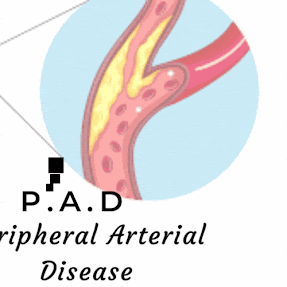Peripheral artery disease, PAD, is a common circulatory condition in which peripheral arteries are narrowed, reducing blood flow. While PAD can occur in any organ or body part, the lower limbs are the most commonly affected! The major cause of PAD is the building up of plaques in arteries, known as atherosclerosis.
Plaques are deposits of lipids, fibrous tissue, and calcium, that accumulate slowly over time. Less commonly, an artery may suddenly be blocked by a blood clot, or embolus. Rarer causes include blood vessel inflammation, injury, or unusual anatomy of ligaments or muscles. The impact of reduced blood flow, or ischemia, is most remarkable when there is a higher demand for blood supply, such as during physical activities. This is why people who are not very active may not experience any symptoms initially. It also explains the most tell-tale sign of PAD, known as intermittent claudication - a painful or tired feeling in the legs that occurs while walking, but is rapidly relieved by rest.
The affected leg and foot may lose color and feel cold, especially when the foot is elevated. There may also be a lack of growth of toenails and hair. The location of the pain depends on the site of obstruction. The more proximal the site of the blockage, the more widespread the pain. The calf is the most common site of pain. As the disease progresses, patients may experience pain even during rest. This advanced stage is known as critical limb ischemia, a chronic, slow-developing condition.
Patients may develop ulcers that heal slowly or not at all; and death of tissue, or gangrene, may occur. The risk for loss of a limb is significantly increased at this stage. Acute limb ischemia happens when there is a sudden blockage of blood flow, typically due to an embolism or thrombosis. Acute limb ischemia is an emergency threatening loss of limb. Any factors that increase risks for atherosclerosis also increase risks for PAD. Because atherosclerosis can affect any artery in the body, PAD patients are also likely to have coronary artery disease or carotid artery disease.
Diagnosis is based on
symptoms, medical history, physical exam, and a number of tests. The purpose of
the physical exam is to look for signs such as weak pulses, whooshing
sounds of obstructed blood flow, and evidence of poor wound healing. Blood
tests are done to evaluate cholesterol, triglyceride, and blood sugar levels.
Ankle-brachial index test, or ABI test, is commonly performed to compare blood
pressures in the ankle and the arm. An ABI lower than 0.9 indicates PAD.
Imaging procedures may be performed to identify the affected arteries.
Treatments aim to relieve symptoms, re-establish blood flow to reduce the risk of
losing a limb, and stop the progression of atherosclerosis to lower the risk
of heart attack and strokes. Treatment options include lifestyle changes, exercise
programs, medications, and/or procedures to open or bypass blockages in
the arteries.
Helping current and future clinicians focus to learn to retain and thrive
Thank You




